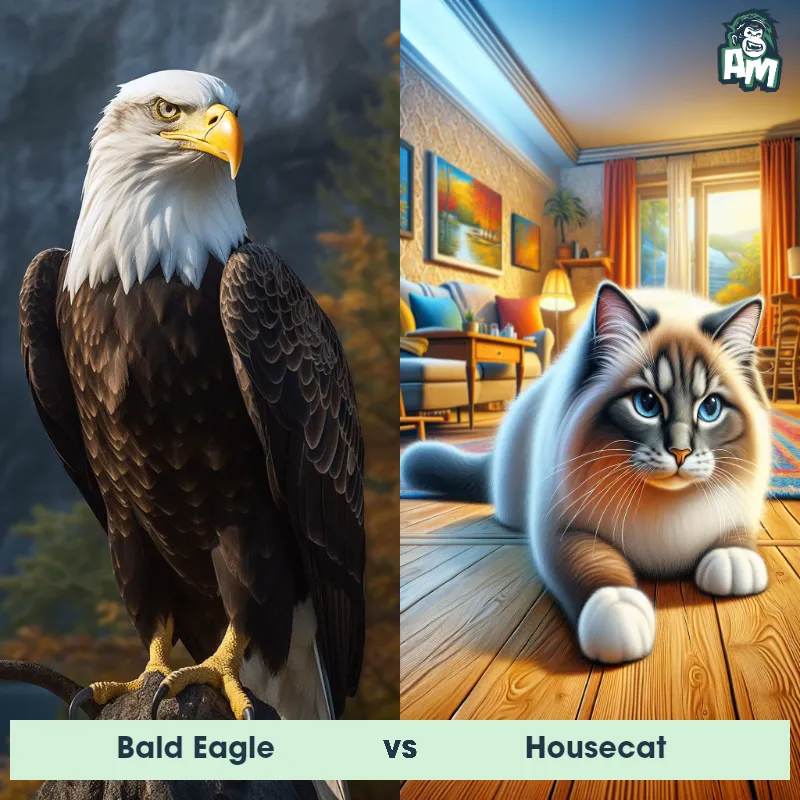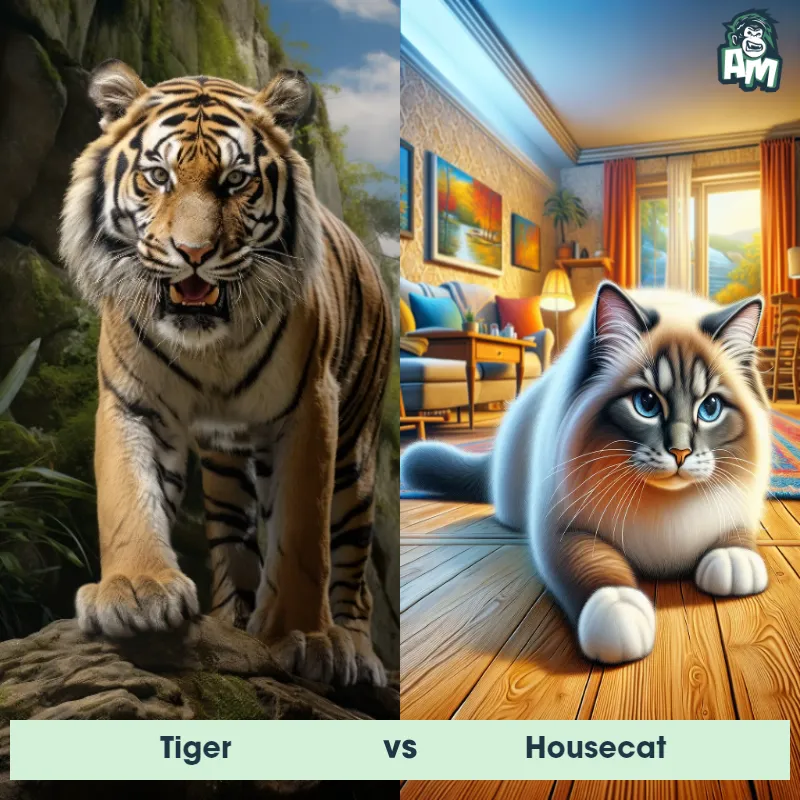The Housecat
The Housecat, commonly known as domestic cat Felis catus, is a small carnivorous mammal that belongs to the family Felidae. These adorable creatures are known for their soft and shiny fur, which comes in a wide variety of colors and patterns. They have sharp retractable claws that aid them in hunting, climbing, and self-defense. Housecats have excellent agility and are known for their ability to jump and pounce with precision. They have a heightened sense of hearing and sight, making them efficient hunters. Domestic cats have adapted well to living with humans and are highly social animals.

| Housecat | |
|---|---|
| Size | Height: 9-10 inches (22-25 cm) |
| Weight | 8-10 pounds (3.6-4.5 kg) |
| Speed | 30mph (48km/h) |
| Key Strength | Stealth and agility |
| Biggest Weakness | Size and physical strength |
| Scientific Name | Felis catus |
| Family | Felidae |
| Habitat | Domestic, indoor environments |
| Geography | Worldwide, found in many countries |
| Diet | Carnivorous, primarily eat meat-based cat food |
| Lifespan | 12 years - 16 years |

The Housecat
The Housecat, commonly known as domestic cat Felis catus, is a small carnivorous mammal that belongs to the family Felidae. These adorable creatures are known for their soft and shiny fur, which comes in a wide variety of colors and patterns. They have sharp retractable claws that aid them in hunting, climbing, and self-defense. Housecats have excellent agility and are known for their ability to jump and pounce with precision. They have a heightened sense of hearing and sight, making them efficient hunters. Domestic cats have adapted well to living with humans and are highly social animals.
Fun Fact: Housecats have a unique ability called "rehoming," where they can navigate their way back to their original territory even if they have been relocated or taken far away from it, thanks to their exceptional navigational skills and sense of direction.
| Housecat | |
|---|---|
| Size | Height: 9-10 inches (22-25 cm) |
| Weight | 8-10 pounds (3.6-4.5 kg) |
| Speed | 30mph (48km/h) |
| Key Strength | Stealth and agility |
| Biggest Weakness | Size and physical strength |
| Scientific Name | Felis catus |
| Family | Felidae |
| Habitat | Domestic, indoor environments |
| Geography | Worldwide, found in many countries |
| Diet | Carnivorous, primarily eat meat-based cat food |
| Lifespan | 12 years - 16 years |
Housecat Matchups
We use AI to simulate matchups between the Housecat and other animals. Our simulation considers size, strength, and natural predatory behaviors to determine the most likely outcome.

Can't find the Matchup you want?
Create Your Own MatchupHousecat: Diet, Predators, Aggression, and Defensive Behaviors
What do Housecats eat?
Housecats are obligate carnivores, meaning they must eat meat to survive. Their diet primarily consists of animal protein, including commercial cat food, raw meat, or even small prey like birds or rodents. It's important for cat owners to provide balanced nutrition to ensure their cats are healthy and thriving.
Do Housecats have any predators?
Although Housecats are predators themselves, they can still fall prey to larger animals such as dogs, coyotes, foxes, or even birds of prey like eagles or owls. Outdoor cats are particularly vulnerable to attacks from other animals, so it's important to keep them supervised or indoors to minimize the risk of becoming prey.
Are Housecats aggressive?
Housecats can exhibit aggressive behaviors, especially when they feel threatened or cornered. However, most domesticated cats are more likely to use defensive tactics like hissing, swatting, or hiding when faced with a potential threat. Proper socialization and training can help prevent aggressive tendencies in Housecats.
Do Housecats fight?
Housecats, particularly unaltered males, may engage in fights with other cats over territory, mates, or resources. These fights can be loud, intense, and result in injuries like scratches or bites. It's important for cat owners to spay/neuter their cats to reduce aggressive behavior and minimize the risk of fights.
How do Housecats defend themselves?
Housecats have several defense mechanisms to protect themselves from threats. They may use their sharp claws and teeth to fend off attackers, vocalize loudly to intimidate foes, or run and hide to avoid confrontation. Cats are known for their agility, speed, and flexibility, which they use to their advantage in self-defense situations.
What is the Housecat's biggest weakness in a fight?
Despite their sharp claws and teeth, Housecats are relatively small and agile compared to larger predators. In a fight, their size and strength may be a disadvantage when facing off against more formidable opponents like dogs or wild animals. Additionally, Housecats may lack the combat experience or survival instincts needed to outmatch their adversaries in a physical confrontation.
Fun Fact: Housecats have five toes on their front paws but only four on their back ones, making a total of 18 toes instead of the usual 20 toes of most members of the cat family.
Fun Fact: The average Housecat sleeps for about 12 to 16 hours a day, allowing them to conserve energy for hunting and play. This excessive sleeping habit is due to their evolutionary history as nocturnal animals, allowing them to adapt to their natural hunting patterns.














